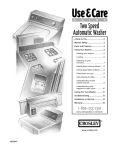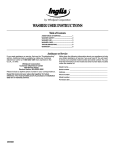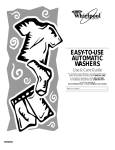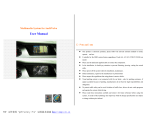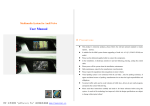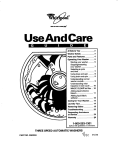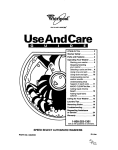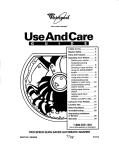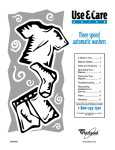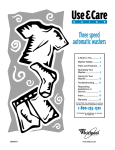Download Whirlpool LBR4132HQ0 User's Manual
Transcript
Automatic Washers A Note to You ...........................................2 Washer Safety..........................................3 Parts and Features ..................................4 Using Your Washer..................................5 Starting your washer .............................5 Loading .................................................7 Selecting a cycle and time ....................8 Using the liquid chlorine bleach dispenser .................................12 Adding liquid chlorine bleach ..............12 Using the fabric softener dispenser ....13 Adding liquid fabric softener................13 Rinse/drain and spin ...........................14 MAGIC CLEAN® lint filter ....................14 Understanding normal washer sounds..14 Understanding what happens in each cycle ...........................................15 Caring For Your Washer .......................16 Troubleshooting ....................................17 Assistance or Service ...........................20 Warranty .................................................24 In the U.S.A. for assistance or service, call the Consumer Assistance Center: 1-800-253-1301 In Canada, for assistance or service, see page 21. 3950316 A NOTE TO YOU Thank you for buying a WHIRLPOOL appliance. ® The Whirlpool Brand is committed to designing quality products that consistently perform for you to make your life easier. To ensure that you enjoy years of trouble-free operation, we developed this Use and Care Guide. It is full of valuable information about how to operate and maintain your appliance properly and safely. Please read it carefully. Also, complete and mail the Ownership Registration Card provided with your appliance. The card helps us notify you about any new information on your appliance. Please record your model’s information. Whenever you call to request service for your appliance, you need to know your complete model number and serial number. You can find this information on the model and serial number label (see the diagram on the “Parts and Features” page for the location of the label). Also, record the other information shown in the next column. Model Number ______________________________ Serial Number________________________________ Purchase Date ______________________________ Dealer Name ________________________________ Dealer Address ______________________________ Dealer Phone ________________________________ Keep this book and the sales slip together in a safe place for future reference. Our Consumer Assistance Center number is toll free. 1-800-253-1301 To find detailed product information, the location of the nearest Whirlpool dealer or authorized servicer, to purchase an accessory item, or register your appliance on-line, please visit our Web site at www.whirlpool.com In Canada, for assistance or service, see the “Assistance or Service” section. In Canada, visit our Web site at www.whirlpool.com/canada 2 WASHER SAFETY Your safety and the safety of others is very important. We have provided many important safety messages in this manual and on your appliance. Always read and obey all safety messages. This is the safety alert symbol. This symbol alerts you to hazards that can kill or hurt you and others. All safety messages will be preceded by the safety alert symbol and the word “DANGER” or “WARNING.” These words mean: wDANGER You will be killed or seriously injured if you don’t follow instructions. wWARNING You can be killed or seriously injured if you don’t follow instructions. All safety messages will identify the hazard, tell you how to reduce the chance of injury, and tell you what can happen if the instructions are not followed. IMPORTANT SAFETY INSTRUCTIONS WARNING – To reduce the risk of fire, electric shock, or injury to persons when using the washer, follow basic precautions, including the following: • Read all instructions before using the • Do not allow children to play on or in the washer. washer. Close supervision of children is Do not wash articles that have been necessary when the washer is used near • previously cleaned in, washed in, soaked children. in, or spotted with gasoline, dry cleaning • Before the washer is removed from service solvents, other flammable or explosive or discarded, remove the lid. substances as they give off vapors that • Do not reach into the washer if the tub or could ignite or explode. agitator is moving. • Do not add gasoline, dry cleaning Do not install or store the washer where it solvents, or other flammable or explosive • will be exposed to the weather. substances to the wash water. These • Do not tamper with controls. substances give off vapors that could • Do not repair or replace any part of the ignite or explode. washer or attempt any servicing unless • Under certain conditions, hydrogen gas specifically recommended in this Use and may be produced in a hot water system Care Guide or in published user-repair that has not been used for 2 weeks or instructions that you understand and have more. HYDROGEN GAS IS EXPLOSIVE. the skills to carry out. If the hot water system has not been • See Installation Instructions for grounding used for such a period, before using the requirements. washing machine, turn on all hot water faucets and let the water flow from each for several minutes. This will release any accumulated hydrogen gas. As the gas is flammable, do not smoke or use an open flame during this time. – SAVE THESE INSTRUCTIONS – 3 PARTS AND FEATURES The drawings in this book may vary from your washer model. They are designed to show the different features of all models covered by this book. Your model may not include all features. Water temperature selector* (p. 6) Load size selector (p. 5) Cycle control knob (may include temperature selector) (pp. 6-11) / Heavy Super Wash Normal Spin Quick Heavy Duty city Super Capa 5Cycle Cycle Logic 2 Speed Laundry System Wash OFF 15 9 6 Rinse Rinse 3 6 Spin OFF Extra Rinse OFF Spin Spin Extra Rinse OFF OFF Spin On Medium Off Super Plus 9 6 Rinse 9 bles Hand Washa t Agitate) (Intermitten Delicates Small Quick Wash Pause 6 OFF Cool Cool wn Down Do SpinExtra Rinse Rinse OFFSpin Extra Rinse Load Size Liquid fabric softener dispenser* (pp. 5, 13) Pull to Start Stop Push to / P. Press Resist Wrinkle U ( In U.S.A.) Center 53-1301 1-800-2er Assistance Consum Liquid chlorine bleach dispenser* (pp. 5, 12) Model and serial number label (under lid) Basket Tub XTRA ROLL ACTION™ agitator* (p. 15) MAGIC CLEAN® lint filter* (bottom of washer basket) (p. 14) Additional features: CLEAN TOUCH™ control pad* (p. 6) Cycle signal selector* (p. 6) Extra rinse selector* (p. 6) * On some models 4 USING YOUR WASHER wWARNING Fire Hazard Never place items in the washer that are dampened with gasoline or other flammable fluids. No washer can completely remove oil. Do not dry anything that has ever had any type of oil on it (including cooking oils). Doing so can result in death, explosion, or fire. wWARNING Electrical Shock Hazard Plug into a grounded 3 prong outlet. Do not remove ground prong. Do not use an adapter. Do not use an extension cord. Failure to follow these instructions can result in death, fire, or electrical shock. STARTING YOUR WASHER 1. Measure detergent and pour it into the washer. If desired, add powder or liquid color-safe bleach. 4. (OPTIONAL STEPS) If desired, pour measured liquid fabric softener into the liquid fabric softener dispenser (on some models). See “Using the liquid fabric softener dispenser” later in this section.” 5. Close the washer lid. 2. Drop a sorted load of clothes loosely into your washer, filling to the top row of holes. • Load evenly to maintain washer balance. • Mix large and small items. See the “Loading” section. 3. (OPTIONAL STEPS) If desired, add measured liquid chlorine bleach to the bleach dispenser (on some models). See “Using the liquid chlorine bleach dispenser” later in this section. 6. Set the Load Size selector to the correct setting for your wash load and the type of fabric being washed. • Choose a water level that allows the load to move freely. See “Loading” later in this section. • To change the setting after the water has started filling, turn the selector to a different setting. 5 USING YOUR WASHER STARTING YOUR WASHER (CONT.) 7. Set the Water Temperature selector (on some models) to the correct setting for the type of fabrics and soils being washed. NOTE: On models without a separate Water Temperature selector, see “Cycle Options” in the “Selecting a Cycle and Time” section. • Use the warmest water safe for fabric. 10. Push in the Cycle Control knob and turn it clockwise to the desired wash cycle. See “Selecting a cycle and time” later in this section. 11. Pull out the Cycle Control knob to start the washer. • Follow garment label instructions. HOT: 120°F (49°C) or above. – Whites and pastels. – Heavy and greasy soils. WARM: 90 to 110°F (32 to 44°C). – Bright colors. – Moderate to light soils. COLD: 70 to 90°F (21 to 32°C). – Colors that bleed or fade. – Light soils. 8. (OPTIONAL STEP) Some models have an Extra Rinse selector. For an additional rinse and spin at the end of a wash cycle, set the Extra Rinse selector to ON. 9. (OPTIONAL STEP) Some models have an end of cycle signal. Set the Cycle Signal to ON if you want the washer to alert you when the wash cycle is complete. 6 12. (OPTIONAL STEP) On models without bleach dispenser, if desired, add measured liquid chlorine bleach after the washer starts agitating. See “Adding Liquid Chlorine Bleach” later in this section. 13. (OPTIONAL STEP) On models without fabric softener dispenser, if desired, add measured liquid fabric softener to the rinse water. See “Adding Liquid Fabric Softener” later in this section. NOTE: To stop the washer at any time, push in the Cycle Control knob. To restart the washer, close the lid (if open) and pull out the Cycle Control knob. USING YOUR WASHER LOADING Loading suggestions For these suggested full-sized loads, set the Load Size selector to the highest water level setting. EXTRA LARGE CAPACITY WASHERS Heavy Work Clothes 2 pair pants 3 shirts 3 pair jeans 1 coverall Knits 2 slacks 2 blouses 4 shirts 4 tops 2 dresses Permanent Press 1 double sheet 1 tablecloth 1 dress 1 blouse 2 slacks 3 shirts 2 pillowcases Mixed Load 2 double or 1 king size sheet(s) 4 pillowcases 6 T-shirts 6 pair shorts 2 shirts 2 blouses 6 handkerchiefs Towels 8 bath towels 8 hand towels 10 wash cloths 1 bath mat Towels 10 bath towels 10 hand towels 14 wash cloths 1 bath mat Mixed Load 3 double sheets 4 pillowcases 8 T-shirts 6 pair shorts 2 shirts 2 blouses 8 handkerchiefs Delicates 2 camisoles 4 slips 4 panties 2 bras 2 nighties SUPER CAPACITY WASHERS Heavy Work Clothes 3 pair pants 3 shirts 4 pair jeans 1 coverall 1 overall Delicates 3 camisoles 1 quilted robe 4 slips 4 panties 2 bras 2 nighties 1 baby’s dress 7 USING YOUR WASHER SELECTING A CYCLE AND TIME • The washer pauses briefly throughout each cycle. This section describes the available wash cycles and will help you make the best cycle selections for your wash loads. Each cycle is designed for different types of fabric and soil levels. NOTE: This book covers one-, two-, and three-speed washer models. Compare your washer’s Cycle Control knob with those shown. Once you find the knob that looks like your model, refer to the cycle descriptions that follow. • These pauses are normal. Refer to “Understanding normal washer sounds” to learn more about the sounds you may hear during a wash cycle. Refer to “Understanding what happens in each cycle” later in this section to learn what happens during a wash cycle. One-speed models Spin Off Regular 10 Light Permanent Press Normal CO Rinse 6 Regular 14 18 Rinse Heavy Off Spin 12 14 Off Off Spin Spin 10 Spin 10 Off 20 Off Spin Pause Cool Down LD FI LL Rinse Normal WARM FILL 10 Spin 14 Pul Push Off 8 6 Rinse Delicates CO Soak Rinse 8 Pull Start Push Stop 6 L CO D W A Pre-Wash 4 T Cool Down HO Pause WARM Heavy Super Wash Rinse 6 8 10 HOT Regular LD RM Normal Heavy Regular Permanent Press USING YOUR WASHER SELECTING A CYCLE AND TIME (CONT.) (One-speed models) Normal Cycle Delicates Cycle The Normal cycle features high-speed agitation for maximum cleaning, and high-speed spin to shorten drying time. Select up to 14 minutes of wash time to clean large loads of sturdily constructed fabrics that are heavily soiled. Select less wash time to clean washable knits, cottons, permanent press, and some synthetic fabrics that are lightly to moderately soiled. The Delicates cycle features brief agitation and soak periods, followed by shorter spins. Use this 6-minute cycle to clean delicate items and washable knits that are lightly or moderately soiled. Soak Cycle Select the 18-minute Super Wash feature to wash heavily soiled loads that need maximum soil removal. Use two times the recommended amount of detergent for this cycle. The Soak Cycle features brief periods of agitation and soak time to remove heavy soils and stains that need pretreatment. Use warm water when soaking laundry. Hot water can set stains. Use the amount of detergent or presoak additive recommended by the manufacturer. When the Soak cycle ends, add detergent and start a new wash cycle. Permanent Press Cycle Pre-Wash Cycle The Permanent Press cycle features a cool-down rinse to minimize wrinkling of permanent press blends and synthetic fabrics. Select 6 to10 minutes of wash time to clean lightly to moderately soiled loads. The 4-minute Pre-Wash cycle features a brief period of agitation to help remove heavy soils and stains that need pretreatment. When the Pre-Wash cycle ends, add detergent and start a new wash cycle. Super Wash Cycle Cycle options (models without a separate Water Temperature selector) You may select different wash time and water temperature combinations by first selecting the Water Temperature and then turning to the new wash time. For example, for 14 minutes of wash time in the Normal cycle with Cold water: 1. Push in the Cycle Control knob, and turn it clockwise to the Cold setting. 2. Pull out the Cycle Control knob and allow washer to fill. 3. When washer has filled, push in and turn the Cycle Control knob to 14 minutes of wash time. 4. Pull out the Cycle Control knob to start washer. 9 USING YOUR WASHER SELECTING A CYCLE AND TIME (CONT.) Two- and three-speed models Rinse Spin Off Ex Heavy Heavy Normal Regular Softwash 9 6 15 12 Light Normal Regular Heavy 6 Off Spin Spin Off Off Off 10 Spin Regular Pause Off Spin Extra Delicates Rinse Off Spin Permanent Press Regular Light X-Rinse SpinOff 9 Off 6 Spin Normal Rinse Permanent Press Pause Softwash 6 Regular 9 Heavy 12 CO LD WA RM Knits / Gentle Normal 8 Off HO T Cold Spin Rinse Cold Rinse Regular OLD C Heavy Cool Down 10 Spin 14 Rinse Off Off Spin Off Extra Rinse Spin Extra Rinse Off Spin 10 Spin Off Cold Rinse 6 Pause Rinse 10 6 Off Rinse Spin Extra Off Rinse Delicates Short/Knits Permanent Press COL D Spin WARM 18 Off Hand Washables Pull Start Push Stop Pause Cool Down Light Cool Down Rinse W ar m 3 6 Cold Rinse 9 6 Permanent Press CO LD Rinse WARM Spin Off HOT Extra Rinse Spin Super Wash Cold Rinse Off Extra Rinse Light Regular 6 10 14 Rinse Spin LD CO M AR W HO T Quick Wash 8 CO LD WA RM Off Spin Cold Rinse Cool Down Pull Start Push Stop USING YOUR WASHER SELECTING A CYCLE AND TIME (CONT.) (Two- and three-speed models) Normal Cycle Extra Delicate Cycle The Normal cycle features high-speed agitation followed by a brief period of low-speed agitation for cleaning cottons and linens. High spin speeds shorten drying time. Select 6 to 15 minutes of wash time, depending on model, for loads that are moderately or heavily soiled. For lightly soiled cotton and linen fabrics, use the shortest time setting. The Extra Delicate cycle features an extra low speed agitation for gentle soil removal from delicate items and washable knits. Low spin speeds minimize wrinkling. Select this 6-minute cycle to clean light to moderately soiled items. Super Wash Select the 18-minute Super Wash feature to wash heavily soiled loads that need maximum soil removal. Use two times the recommended amount of detergent for this cycle. Permanent Press Cycle The Permanent Press cycle starts with high-speed agitation and then steps down to low-speed agitation for cleaning permanent press blends and synthetic fabrics. To minimize wrinkling, this cycle features a cool-down rinse and a low-speed final spin. Select 4 to 10 minutes of wash time, depending on model, to clean lightly to moderately soiled loads. Delicate Cycle The Delicate cycle features an extra-low-speed agitation for gentle soil removal from delicate items and washable knits. Low spin speeds minimize wrinkling. Select 3 to 6 minutes of wash time, depending on model, to clean lightly to moderately soiled loads. Hand Washables or Ultimate Care Cycle The Hand Washables (or Ultimate Care) cycle, features a series of brief, extra-low-speed agitations and short soaks to gently clean special-care items. Low spin speeds minimize wrinkling. Six-minute wash time cleans lightly soiled hand washables. Wash small loads. If items appear to be floating (due to trapped air), stop the washer by pushing in the Cycle Control knob. Push items down into the water. Restart the washer. Quick Wash Cycle Knits/Gentle or Short/Knits Cycle The Knits/Gentle (or Short/Knits) cycle features a brief soak and reduced agitation speed for gentle soil removal. Low spin speeds reduce wrinkling. Use this cycle for cleaning delicate items and washable knits that are lightly, moderately or heavily soiled. The Quick Wash cycle features low agitation speed for gentle soil removal, while providing shortened wash/rinse, drain and spin times. High spin speed shortens drying time. Use this 6-minute cycle with a low water level and a warm wash for lightly soiled items that you need in a hurry. Cycle options (models without a separate Water Temperature selector) You may select different wash time and water temperature combinations by first selecting the Water Temperature and then turning to the new wash time. For example, for 14 minutes of wash time in the Normal cycle with Cold water: 1. Push in the Cycle Control knob, and turn it clockwise to the Cold setting. 2. Pull out the Cycle Control knob and allow washer to fill. 3. When washer has filled, push in and turn the Cycle Control knob to 14 minutes of wash time. 4. Pull out the Cycle Control knob to start washer. 11 USING YOUR WASHER USING THE LIQUID CHLORINE BLEACH DISPENSER Always measure liquid chlorine bleach. Do not guess. Never use more than 1 cup (250 mL) for a full load. Use less with smaller Load Size settings. Follow manufacturer’s directions for safe use. Use a cup with a pouring spout to avoid spilling. 1. Load the washer. 2. Pour measured liquid chlorine bleach carefully into the dispenser. Do not let bleach splash, drip, or run down into washer basket. Undiluted bleach will damage any fabric it touches. 3. Start the washer. Bleach will be diluted and dispensed automatically during wash part of cycle. NOTE: Do not use this dispenser to add powdered chlorine or color safe bleach to your wash load. The dispenser is for liquid chlorine bleach use only. ADDING LIQUID CHLORINE BLEACH (on models with no dispenser) Always measure liquid chlorine bleach. Do not guess. Never use more than 1 cup (250 mL) for a full load. Follow manufacturer’s directions for safe use. Use a cup with a pouring spout to avoid spilling. 1. Let the washer fill and begin agitating the load. 2. Add bleach to the wash cycle so it can be removed in the rinse cycle. Pour bleach around the agitator, not directly on the load. 12 • Follow directions on care labels. Do not use • chlorine bleach on wool, silk, spandex, acetates, or some flame-retardant fabrics. When soaking with chlorine bleach, add detergent to soak water. NOTE: Undiluted bleach will damage any fabric it touches. The damage appears as rips, holes, tears, or color loss and may not show up until several washings later. USING YOUR WASHER USING THE LIQUID FABRIC SOFTENER DISPENSER 1. Add detergent and load clothes into the basket. 2. Pour liquid fabric softener into the dispenser using the amount recommended on the package. Avoid dripping or spilling any fabric softener on the load. 3. Dilute fabric softener with warm water. Fill dispenser with warm water until liquid reaches the cross bar in the opening. 4. Start the washer. Diluted fabric softener will be added to the load during the final rinse. NOTE: Do not stop the washer before the rinse part of the cycle begins. Staining can occur. Cleaning the liquid fabric softener dispenser Flush dispenser periodically with warm water, as illustrated. • To remove the dispenser, grasp the top of the dispenser with both hands. Squeeze and push upward with thumbs to remove. • Clean dispenser by holding under water faucet. Replace after cleaning. NOTE: Do not wash clothes with this dispenser removed. Do not add detergent or bleach to dispenser. The dispenser is for liquid fabric softener use only. ADDING LIQUID FABRIC SOFTENER (on models with no dispenser) • Always dilute fabric softener with • • ⁄2 to 1 cup (125 to 250 mL) warm water. Undiluted fabric softener can stain fabrics. Add diluted fabric softener only in the final rinse. Fabric softener should not be mixed with other laundry products because greasy stains may form. If stains form, remove them by wetting the stain and rubbing with liquid detergent or a bar of soap. Rewash the stained item. 1 • Too much fabric softener can make some items (diapers and towels) nonabsorbent. If this happens, use less fabric softener or do not use it every time. 13 USING YOUR WASHER RINSE/DRAIN AND SPIN Rinse and Spin Drain and Spin When using extra detergent for heavily soiled clothes, or washing special-care items, you may find an extra rinse and spin is needed. 1. For an additional rinse and spin at the end of the wash cycle, push in the Cycle Control knob and turn it clockwise to Rinse. 2. Pull out the Cycle Control knob. The washer fills to the selected load size, agitates, drains and spins. NOTE: An Extra Rinse option is available on some models. See “Starting Your Washer.” A drain and spin may help shorten drying times for some heavy fabrics or special-care items by removing excess water. 1. For a drain and spin, push in the Cycle Control knob and turn it clockwise to any of the Spin settings. 2. Pull out the Cycle Control knob. The washer drains, then spins. MAGIC-CLEAN ® LINT FILTER (on some models) Your washer has a self-cleaning lint filter at the bottom of the basket. Wash and rinse water flow over the filter during agitation, separating the lint from the water. The lint spins out of the system during the spin part of the cycle. Basket interior If your washer drains into a tub, remove any lint collected in the tub or strainer. Self-cleaning lint filter UNDERSTANDING NORMAL WASHER SOUNDS Your new washer may make sounds your old one didn’t. Because the sounds may be unfamiliar, you may be concerned about them. Don’t be; most of them are normal. The following describes some of the sounds you may hear and what causes them. During drain If water is drained quickly from your washer (depending on your installation), you may hear air being pulled through the pump during the end of draining. After drain and before spin When the cycle changes from draining to spinning, you may hear gears engaging. 14 USING YOUR WASHER UNDERSTANDING WHAT HAPPENS IN EACH CYCLE When the Cycle Control knob is set to a number and pulled out, the washer fills (to the selected load size) before agitation and timing start. The washer begins agitating immediately after filling; agitation occurs with the washer lid up or down. During agitation, the XTRA ROLL ACTIONTM agitator (on some models) creates a continuous rollover action that provides a thorough cleaning of the wash load. After agitation starts, the Cycle Control knob turns clockwise until it points to an OFF area and the cycle ends. NOTES: • The washer pauses briefly throughout each cycle. These pauses are normal for washer operation. • On some models, a Gentle Wash system helps protect your fabrics by reducing wash agitation speed during the last few minutes of wash agitation in the Normal and Permanent Press cycles. Sequence of cycles WASH RINSE Fill ▼ Fill ▼ Wash selected time ▼ Rinse ▼ Drain* No agitation ▼ Drain-No agitation ▼ Spin ▼ Spin-Spray rinse ▼ * The Permanent Press cycle partially drains, fills, agitates Spin ▼ briefly, and drains. Off 15 CARING FOR YOUR WASHER CLEANING YOUR WASHER Cleaning the exterior Cleaning the interior Use a soft, damp cloth or sponge to wipe up any spills such as detergent or bleach. Occasionally wipe the outside of your washer to keep it looking new. Clean your washer interior by mixing 1 cup (250 mL) of chlorine bleach and 2 cups (500 mL) of detergent. Pour this into your washer and run it through a complete cycle using hot water. Repeat this process if necessary. NOTE: Remove any hard water deposits using only cleaners labeled as washer safe. WINTER STORAGE, MOVING, VACATION CARE Install and store your washer where it will not freeze. Because some water may stay in the hoses, freezing can damage your washer. If storing or moving your washer during freezing weather, winterize it. To winterize washer: 1. Shut off both water faucets. 2. Disconnect and drain water inlet hoses. 3. Put 1 quart (1 L) of R.V.-type antifreeze in the basket. 4. Run washer on a drain and spin setting (see the “Drain and spin” section) for about 30 seconds to mix the antifreeze and water. 5. Unplug washer or disconnect power. To use washer again: 1. Flush water pipes and hoses. 2. Reconnect water inlet hoses. 3. Turn on both water faucets. 4. Plug in washer or reconnect power. 5. Run the washer through a complete cycle with 1 cup (250 mL) of detergent to clean out antifreeze. Non-use or vacation care: Operate your washer only when you are at home. If you will be on vacation or not using your washer for an extended period of time, you should: • Unplug the power supply cord or turn off electrical power to the washer. • Turn off the water supply to the washer. This helps avoid accidental flooding (due to a water pressure surge) while you are away. INLET HOSES Replace inlet hoses after 5 years of use to reduce When replacing your inlet hoses, mark the date of the risk of hose failure. Inspect and replace inlet replacement on the label with a permanent marker. hoses if bulges, kinks, cuts, wear, or leaks are found. 16 TROUBLESHOOTING COMMON WASHING PROBLEMS Problem... Cause... Solution ... Washer leaks NOTE: After checking these, check household plumbing. • Fill hoses not tight. • Tighten hoses. See Installation • Fill hose washers not properly seated. • Reseat (reposition) washers. See • • • • • • causing water to deflect off tub ring. Unit not level, causing water to deflect off tub ring. Fill or spray rinses are deflecting off load. Washer is overloaded or load is unbalanced. Installation Instructions. Clamp drain hose. • Unclog drain. Sink and standpipe • Tub moved forward during unloading, • Washer won’t drain/spin Drain hose clamp not properly installed or is off. Drain is clogged. Instructions. • must be able to handle 17 gallons (64 L) of water per minute. Ensure tub is centered before starting washer. Ensure front feet are installed and nuts are tightened. Level washer. Redistribute the load, or reduce load size. • Drain hose is clogged. • Unclog hose. See Installation • Lid is open. • End of drain hose more than • • • • • Use less detergent. • Check electrical source or call 72 inches (183 cm) above floor. Too much detergent – excessive sudsing. Low voltage or using an extension cord. Instructions for proper installation of drain hose. Close the lid. Lower drain hose. electrician. Do not use extension cords. • Wrong cycle for load being washed. • Choose a cycle with a higher spin • Cold rinses. • Cold rinses leave loads wetter than Washer continues to fill/drain or cycle stuck NOTE: Washer pauses briefly throughout each cycle. This is normal. • Top of drain hose is lower than water • Raise the drain hose. It must be • • • Drain hose taped into standpipe. • Washer makes noise • Load is unbalanced. • Washer is not level. • Redistribute load. • Level washer. Reset rear leveling Wet loads level in washer. Drain hose fits too tightly into standpipe. speed. warm rinses. This is normal. higher for proper operation. Adjust drain hose for loose yet secure fit. See Installation Instructions. Do not seal off drain hose with tape. The hose needs an air gap. legs. See Installation Instructions. Tighten nuts. See Installation Instructions. • Nuts on front feet not tight. • Yellow shipping strap with cotter pins • • • • This is normal. not completely removed. Gears engaging after drain and before spin. 17 TROUBLESHOOTING COMMON WASHING PROBLEMS (CONT.) Problem... Cause... Solution... Won’t fill/rinse/agitate or wrong temperature • • • • Washer stops Water level seems too low or washer not completely filling Washer tub is crooked Residue or lint on load 18 • • • • • • Power cord not plugged in. Timer (Cycle Control knob) dial is not lined up. Water inlet valve screens are plugged. Water is turned off. Hot and cold hoses are reversed. Inlet hose is kinked. Plug in power cord. Turn timer knob to the right slightly and pull to start. Clean screens. Turn on water. Reverse hoses. Straighten hose. Power cord not plugged in. No power at plug. • • • • • • • Fuse blown or circuit breaker open. • • • Using an extension cord. Timer dial is not lined up. • • • Timer knob not pulled out. • • • Machine is overloaded. • • Wash smaller loads. • Tub is pulled forward when unloading. • • • Tub moves. Unit not level. • • Push tub to center before starting. This is normal. Ensure front feet are installed and nuts tightened. Level washer. Reset rear leveling legs. See Installation Instructions. • Improper sorting. • • Overloading. • • • Paper or tissue in pockets. Not enough detergent. • • • Detergent not dissolving. • • Wash water colder than 70°F (21°C). • The top of the agitator is much higher than the highest water level. This creates a perception of the washer not being full. Plug in power cord. Check electrical source or call electrician. Replace fuse or reset circuit breaker. If problem continues, call electrician. Do not use extension cords. Turn timer to the right slightly and pull to start. Set and pull out knob. This is normal. Sort lint givers (towels, chenille) from lint takers (corduroy, synthetics). Also sort by color. Lint can be trapped in load if overloaded. Wash smaller loads. Clean out pockets before washing. Use enough detergent to hold lint in water. Use wash water warmer than 70°F (21°C). Use wash water warmer than 70°F (21°C). TROUBLESHOOTING COMMON WASHING PROBLEMS (CONT.) Problem... Cause... Solution... Tearing • Overloading. Improper use of washer. • • Improper use of chlorine bleach. • • • • Sharp items not removed from pockets; fasteners not fastened. Items damaged before washing. • Improper use of fabric softener. • • • Iron (rust) in water. Not enough detergent used, causing soil to be redeposited. Dye transfer due to not sorting loads properly. Dye transfer due to not unloading washer promptly. • • • Not removing load promptly. • Unload the washer as soon as it stops. • Not removing load promptly. • Unload the washer as soon as it stops. • Wrong cycle for fabrics being washed. • Use the Permanent Press cycle (if available) to reduce wrinkling. • Overloading. • • Wash water not warm enough to relax wrinkles. Using warm rinses. Hoses reversed. • Loads should move freely during wash. Wash smaller loads. If safe for fabric, use warm or hot wash water. Use cold rinse water. Reverse hoses. Stains on load • • Load is wrinkled Load is tangled/twisted Gray whites, dingy colors • • Overloading. • • • • • • • Clothes wrapped around agitator. Dye transfer. • • • Wash temperature too low. • • Not enough detergent. • • Hard water. • Loads should move freely during wash. Wash smaller loads. Do not pour chlorine bleach directly on load. Wipe up bleach spills. Undiluted bleach will damage fabrics. Clean out pockets before washing. Zip zippers before washing. Mend rips and broken threads in seams before washing. Dilute fabric softener and add to rinse portion of cycle only. Do not drip fabric softener on clothes. Install an iron filter. Use enough detergent to remove soil and hold it in suspension. Sort dark clothing from whites and lights. Unload the washer as soon as it stops. Loads should move freely during wash. Wash smaller loads. Do not wrap items around agitator. Sort dark clothes from whites and lights. Use hot or warm washes, if safe for fabric. Hot water should be at least 120°F (49°C) to clean heavy or greasy soils. Use more detergent for washing heavy soils in cold or hard water. Use more detergent when washing in hard water. 19 ASSISTANCE OR SERVICE IF YOU NEED ASSISTANCE OR SERVICE IN THE U.S.A. Call our Consumer Assistance Center at 1-800-253-1301. Our consultants are available to assist you. When calling: Please know the purchase date, and the complete model and serial number of your appliance (see “A Note to You” section). This information will help us better respond to your request. • Accessory and repair parts sales • Specialized customer assistance (Spanish speak• ing, hearing impaired, limited vision, etc.) Referrals to local dealers, service companies, and repair parts distributors. To locate the designated service company in your area, you can also look in your telephone directory Yellow Pages. Our consultants provide assistance with: • Features and specifications on our full line of appliances • Installation information • Use and maintenance procedures IF YOU NEED REPLACEMENT PARTS If you need to order replacement parts, we recommend that you only use FSP® factory authorized parts. FSP replacement parts will fit right and work right, because they are made to the same exacting specifications used to build every new WHIRLPOOL® appliance. To locate FSP replacement parts in your area, call our Consumer Assistance Center telephone number or your nearest designated service center. FOR FURTHER ASSISTANCE If you need further assistance, you can write to us with any questions or concerns at: Whirlpool Brand Home Appliances Consumer Assistance Center c/o Correspondence Dept. 2000 North M-63 Benton Harbor, MI 49022-2692 Please include a daytime phone number in your correspondence. 20 Gearcase assembly covered by your warranty. ASSISTANCE OR SERVICE IF YOU NEED ASSISTANCE OR SERVICE IN CANADA 1. If the problem is not due to one of the items listed in “Troubleshooting”*... Contact the dealer from whom you purchased your appliance, or call the Inglis Limited Consumer Assistance Centre toll free, 8:30 a.m. – 6 p.m. (EST), at 1-800-461-5681. 2. If you need service*... Contact Inglis Limited from anywhere in Canada at 1-800-807-6777. * When asking for assistance or service, please provide a detailed description of the problem, your appliance’s complete model and serial numbers, and the purchase date. (See the “A Note to You” section.) This information will help us respond properly to your request. FOR FURTHER ASSISTANCE If you need further assistance, you can write to Inglis Limited with any questions or concerns at: Consumer Relations Department Inglis Limited 1901 Minnesota Court Mississauga, Ontario L5N 3A7 Please include a daytime phone number in your correspondence. 21 WHIRLPOOL AUTOMATIC WASHER WARRANTY ® (U.S.A. AND CANADA) LENGTH OF WARRANTY WHIRLPOOL WILL PAY FOR FULL ONE-YEAR WARRANTY FROM DATE OF PURCHASE FSP replacement parts and repair labor to correct defects in materials or workmanship. Service must be provided by a designated Whirlpool service company. LIMITED FIVE-YEAR WARRANTY FROM DATE OF PURCHASE FSP replacement parts for any part of gearcase assembly if defective in materials or workmanship. The gearcase assembly is shown in the “Requesting Assistance or Service” section of this book. FSP replacement parts for any top and lid rust. LIMITED TEN-YEAR WARRANTY FROM DATE OF PURCHASE FSP replacement parts for outer tub should it crack, or fail to contain water, due to defective materials or workmanship. ® WHIRLPOOL WILL NOT PAY FOR A. Service calls to: 1. Correct the installation of your washer. 2. Instruct you how to use your washer. 3. Replace house fuses or correct house wiring or plumbing. B. Repairs when your washer is used in other than normal, single-family household use. C. Pickup and delivery. Your washer is designed to be repaired in the home. D. Damage to your washer caused by accident, misuse, fire, flood, acts of God, or use of products not approved by Whirpool. E. Any labor costs during the limited warranties. F. Replacement parts or repair labor costs for units operated outside the United States and Canada. G. Repairs to parts or systems resulting from unauthorized modifications made to the appliance. H. In Canada, travel or transportation expenses for customers who reside in remote areas. 11/98 WHIRLPOOL CORPORATION SHALL NOT BE LIABLE FOR INCIDENTAL OR CONSEQUENTIAL DAMAGES. Some states and provinces do not allow the exclusion or limitation of incidental or consequential damages, so this exclusion or limitation may not apply to you. This warranty gives you specific legal rights, and you may also have other rights which vary from state to state or province to province. Outside the United States and Canada, a different warranty may apply. For details, please contact your authorized Whirlpool dealer. If you need assistance or service, first see the “Troubleshooting” section of this book. After checking “Troubleshooting,” additional help can be found by checking the “Assistance or Service” section. In the U.S.A., call our Consumer Assistance Center at 1-800-253-1301. For information in Canada: Please contact your authorized Whirlpool dealer or call the Consumer Assistance Centre at 1-800-461-5681 (toll free) between 8:30 a.m. and 6 p.m. EST from anywhere in Canada. For assistance or service in Canada: If you need assistance or service in Canada, first see the “Troubleshooting” section of this book. After checking “Troubleshooting,” additional help can be found by checking the “Assistance or Service” section. 3950316 © 1998 Whirlpool Corporation ® Registered Trademark/™ Trademark of Whirlpool, U.S.A., Inglis Limited licensee in Canada 11/98 Printed in U.S.A.






















